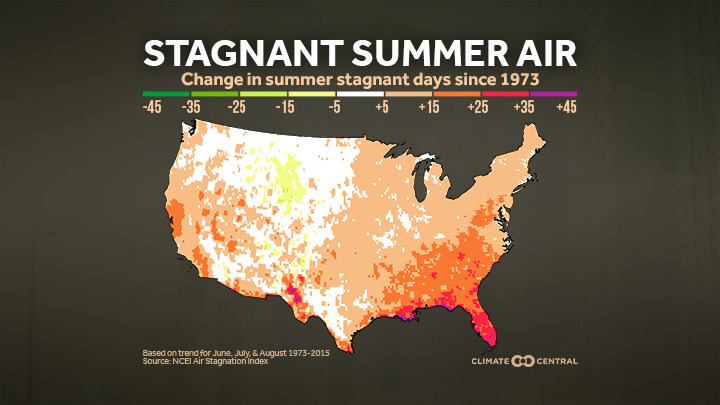Air pollution can be a problem any time of year, but summer often brings conditions that trap pollutants in the lower atmosphere. Nearly stationary domes of hot air are frequently responsible for summer heat waves. This lack of air movement traps pollutants, such as particulates and ozone, causing health problems from respiratory distress to eye irritation.
In this week’s Climate Matters, we look at how the number of summer days (June-August) with stagnant air has changed since 1973 (when this particular data set started). We followed the NCEI Air Stagnation Index (ASI), which uses upper atmospheric winds, surface winds, and precipitation to calculate the level of stagnation on a given day. Over the past four decades, the most substantial increase in summer stagnation days has been in the Southeast and the Southwest, with a noticeable increase in the Northeast. In fact, 66% of the U.S. registered an increase of 5+ stagnant air days over the past four decades.
The combination of heat, sunlight, and pollution creates ground-level ozone, the main component of smog. In the U.S., ozone is estimated to be responsible for thousands of premature deaths each year, tens of thousands of emergency room and hospital visits, and millions of cases of other respiratory conditions leading to missed work and school (USGCRP, Public Health report 2016). Climate Central took the stagnation data a step further, looking at the relationship between this stagnant air and ozone levels in major U.S. cities.
The U.S. has made significant gains in improving air quality due to the Clean Air Act. Concentrations of the major air pollutants have been decreasing overall since 1990. Yet, while average ozone concentrations have decreased, many major U.S. cities still face unhealthy levels of ozone several days each year.
Climate change is expected to increase the frequency of heat waves in the coming decades. With more domes of hot air, more stagnation days could be expected, carrying the risk of worsening air quality — possibly offsetting some of the progress already made to clean up the air.
Methodology: Climate Central analyzed local records of stagnation days (with data available back to 1973), determining local increases based on a trend over the period 1973-2015. We also analyzed the days from May-September each year with high levels of ozone in 35 of the largest U.S. cities to investigate associations between the two (based on EPA designations of unhealthy ozone levels). The focus is on large cities because pollution sources and people at risk of health impacts are both highly concentrated in these locations.
